Egypt, the land of Ancient Egypt and its rich culture, holds a fascination that captivates the imagination. From the majestic Pyramids of Giza to the enchanting Nile River and the bustling city of Cairo, Egypt offers a treasure trove of history and mysteries waiting to be discovered. A journey through this ancient land is a step back in time, where remnants of the past weave a tapestry of wonder and intrigue.
With its biblical importance, Egypt holds a significant place in history. It was a land tied to the lives of notable biblical figures such as Moses, Joseph, and Jesus. The landmarks and landscapes of Egypt played witness to major biblical events, shaping the course of its history.
In biblical times, Egypt was a land of prominence and prosperity. The Pyramids of Giza, standing tall as a testament to human ingenuity and architectural brilliance, were revered as tombs for pharaohs, including the legendary Great Pyramid built for King Khufu. The Nile River, the lifeblood of ancient Egypt, provided sustenance for the people and served as a critical trade route. The city of Luxor, known as Thebes in biblical times, housed magnificent temples where festivals and rituals were performed.
Major biblical events unfolded in Egypt, leaving an indelible mark on its history. The story of the Exodus, led by Moses, saw the liberation of the Israelites from slavery in Egypt. The plagues that befell the land and the parting of the Red Sea are pivotal moments that shaped Egypt’s narrative. These events, along with others, are woven into the rich tapestry of Egypt’s ancient civilization.
Today, Egypt stands as a land of wonder, beckoning travelers to explore its mysteries. The Pyramids of Giza, the Nile River, and the city of Cairo offer glimpses into a bygone era, while the temples of Luxor and the archaeological sites of Abu Simbel and Saqqara provide a deeper understanding of ancient Egyptian culture and history. Egypt continues to be a destination that ignites the imagination, where the past and present blend seamlessly.
Embark on a journey to Egypt and unlock the secrets of its ancient wonders. Immerse yourself in the culture, unravel the mysteries, and witness the enduring legacy of this extraordinary civilization.
Key Takeaways:
- Egypt is home to iconic landmarks like the Pyramids of Giza and the Nile River.
- Ancient Egypt holds biblical importance and is linked to notable figures and events.
- The Pyramids of Giza and the temples of Luxor offer insights into ancient Egyptian civilization.
- A journey through Egypt is a step back in time, uncovering history, culture, and mysteries.
- Explore the wonders of Egypt through its rich heritage and enduring landmarks.
The Seven Wonders of Egypt
Egypt is renowned for its seven wonders, each offering a unique glimpse into the country’s rich history and cultural heritage. From the magnificent structures of the Great Pyramid of Giza to the enigmatic allure of the Great Sphinx, these ancient wonders continue to captivate visitors from all around the world.
The Great Pyramid of Giza
The Great Pyramid of Giza is the oldest and largest pyramid in the Giza Necropolis. Built as a tomb for Pharaoh Khufu, it stands as a testament to the incredible architectural and engineering skills of the ancient Egyptians. Its sheer size and precise construction have made it an iconic symbol of Egypt’s ancient past.
The Great Sphinx
The Great Sphinx of Giza is a mesmerizing wonder, with its half-human, half-lion statue looming over the desert landscape. Believed to represent Pharaoh Khafra, the Sphinx has fascinated scholars and visitors alike. Its mysterious origins and purpose continue to be the subject of debate and speculation.
Temple of Luxor
The Temple of Luxor, located in the city of Thebes, is a remarkable testament to the grandeur of ancient Egyptian architecture. Built by pharaohs Amenhotep III and Ramesses II, this temple was a center for religious festivals and rituals. Its towering statues and intricate hieroglyphs offer a window into the religious practices of ancient Egypt.
Cairo, Abu Simbel, Saqqara, and Temple of Karnak
Cairo, the bustling capital of Egypt, is a treasure trove of historical landmarks and ancient wonders. From the Egyptian Museum, which houses a vast collection of artifacts, to the vibrant streets of Islamic Cairo, the city is a vibrant blend of old and new. Additionally, the rock temples of Abu Simbel, the step pyramid of Saqqara, and the awe-inspiring Temple of Karnak all contribute to Egypt’s rich cultural tapestry.
The Seven Wonders of Egypt – A Table
| Wonder | Description |
|---|---|
| Great Pyramid of Giza | The oldest and largest pyramid, built as a tomb for Pharaoh Khufu. |
| Great Sphinx | A half-human, half-lion statue believed to represent Pharaoh Khafra. |
| Temple of Luxor | A grand temple complex in Thebes, known for its religious festivals. |
| Cairo | The vibrant capital city with historical landmarks and the Egyptian Museum. |
| Abu Simbel | Rock temples dedicated to Pharaoh Ramesses II. |
| Saqqara | Ancient burial ground with the world’s oldest standing step pyramid. |
| Temple of Karnak | A vast temple complex showcasing ancient Egyptian architecture. |
Exploring the seven wonders of Egypt provides visitors with a deeper understanding of the country’s rich cultural and historical legacy. From the ancient pyramids to the majestic temples, each wonder offers a unique perspective on the achievements of the ancient Egyptian civilization.
Ancient Egyptian Civilization
Ancient Egyptian civilization flourished for over 3,000 years and left an indelible mark on history. This fascinating civilization was characterized by powerful pharaohs, elaborate hieroglyphs, and a deep connection to the Nile River. Let’s delve into the various aspects of ancient Egyptian society, including their daily life, religion, art, and architecture.
Hieroglyphs: The Written Language of Ancient Egypt
One of the most distinctive features of ancient Egyptian civilization was their written language, known as hieroglyphs. Hieroglyphs were a complex system of pictorial symbols that represented sounds, ideas, and objects. They were often inscribed on temple walls, tombs, and papyrus scrolls. Deciphering the hieroglyphic script has provided valuable insights into the beliefs, history, and daily life of ancient Egyptians.
The Nile River: The Lifeline of Ancient Egypt
The Nile River played a vital role in the development and sustenance of ancient Egyptian civilization. Its annual flooding provided fertile soil for agriculture, allowing the Egyptians to cultivate crops such as wheat, barley, and flax. The river also served as a crucial transportation route for trade and communication. The ancient Egyptians revered the Nile as a sacred entity and believed it to be the source of life.
| Aspect | Significance |
|---|---|
| Daily Life | Agriculture was the main occupation, with farming practices closely tied to the flooding of the Nile. The society was hierarchical, led by pharaohs and governed by a strict social structure. |
| Religion | The ancient Egyptians worshipped a pantheon of gods and goddesses, attributing divine power to natural phenomena and celestial bodies. They believed in an afterlife and devoted significant resources to funerary rituals and tomb construction. |
| Art and Architecture | Ancient Egyptian art and architecture were highly symbolic and served religious and ceremonial purposes. They adorned their temples, tombs, and palaces with intricate carvings, paintings, and sculptures depicting gods, pharaohs, and divine symbols. |
Legacy and Influence
Ancient Egyptian civilization has left an enduring legacy that influences art, architecture, and cultural practices to this day. The grandeur and engineering prowess displayed in their monumental structures, such as the pyramids and temples, continue to captivate and inspire awe. The decipherment of hieroglyphs has unlocked a wealth of historical knowledge, shedding light on the achievements, beliefs, and customs of this remarkable civilization.
By exploring the wonders of ancient Egyptian civilization, we gain a deeper understanding of our shared human history and the rich tapestry of cultures that have shaped the world we inhabit today.
Pyramids of Giza: A Timeless Wonder
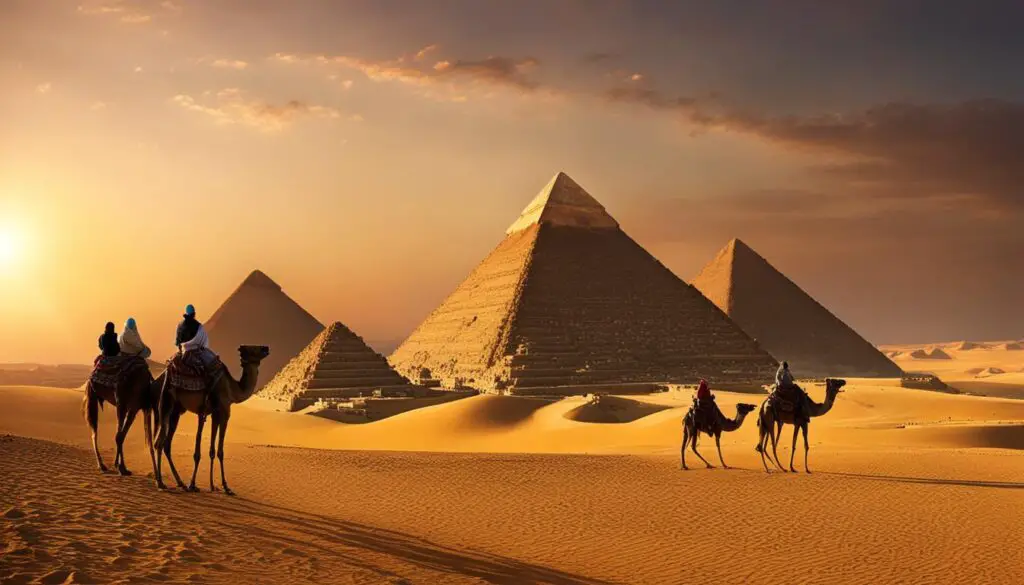
The Pyramids of Giza stand as a testament to the grandeur and architectural brilliance of ancient Egypt. Among the pyramids, the Great Pyramid, also known as the Pyramid of Khufu, is the largest and most iconic. Built as a tomb for the fourth dynasty Egyptian pharaoh Khufu, it has captivated the world with its sheer size and mysterious allure.
The Great Pyramid of Giza is made up of millions of limestone blocks, each weighing several tons. Its precise construction and alignment with the cardinal points of the compass have been a subject of fascination for centuries. As one of the Seven Wonders of the Ancient World, the Great Pyramid continues to amaze visitors with its structural integrity and mathematical precision.
Exploring the Pyramids of Giza offers a glimpse into the ancient tombs and the remarkable architectural achievements of the ancient Egyptians. Inside the pyramids, intricate passageways lead to burial chambers where the pharaohs were laid to rest. The pyramids provide valuable insights into the beliefs and rituals of ancient Egyptian society, as well as the architectural techniques used to construct these monumental structures.
Table: Key Facts about the Pyramids of Giza
| Pyramid | Pharaoh | Height (in meters) | Construction Period |
|---|---|---|---|
| Great Pyramid (Khufu) | Khufu (Cheops) | 146.5 | 2580-2560 BCE |
| Pyramid of Khafre | Khafre (Chephren) | 136.4 | 2558-2532 BCE |
| Pyramid of Menkaure | Menkaure (Mycerinus) | 61 | 2532-2503 BCE |
“The Pyramids of Giza are a testament to the incredible engineering skills and architectural knowledge of the ancient Egyptians. These magnificent structures continue to inspire awe and admiration, offering a fascinating glimpse into the rich history and culture of Egypt.” – Dr. Sarah Williams, Egyptologist
Today, the Pyramids of Giza remain an iconic symbol of Egypt and attract millions of visitors from around the world. Their historical and cultural significance, combined with their magnificent beauty, make them a must-visit destination for anyone interested in ancient civilizations and the wonders of the world.
The Nile River: Lifeblood of Ancient Egypt
The Nile River, with its majestic waters flowing through the heart of ancient Egypt, held immense importance for the civilization. It served as the lifeblood of the land, providing the necessary resources and opportunities that shaped the society and economy of the time. From agriculture to transportation and trade, the Nile River played a pivotal role in the daily lives of the ancient Egyptians.
Agriculture: Sustenance and Prosperity
One of the most significant contributions of the Nile River to ancient Egypt was its role in agriculture. The annual flooding of the river brought nutrient-rich silt that fertilized the surrounding lands, allowing for the cultivation of crops. The floodwaters receded, leaving behind a fertile soil that supported the growth of wheat, barley, and various vegetables. This abundance of agricultural produce not only ensured the sustenance of the population but also led to surplus crops that could be traded or stored for times of scarcity.
Trade and Transportation: Connecting Ancient Egypt
The Nile River also served as a vital trade route and means of transportation, connecting different regions of ancient Egypt. The river provided an efficient mode of transportation for both people and goods, allowing for the movement of resources and facilitating trade between various cities and settlements along its banks. Boats and barges navigated the waters, transporting goods such as grain, pottery, jewelry, and precious metals. The Nile’s strategic location and its network of canals and waterways made it an essential artery for economic and cultural exchange.
Impact on Society and Culture: Sacred and Divine
Beyond its practical significance, the Nile River held a deep cultural and spiritual importance for the ancient Egyptians. They revered the river as a sacred entity, personifying it as the god Hapi, the bringer of life and fertility. The annual flooding of the Nile was seen as a divine act, a renewal of life that sustained their civilization. The river’s significance is evident in ancient Egyptian mythology, art, and religious customs, highlighting its place as a central symbol in their society.
| Major Biblical Events | Impact on the Nile River |
|---|---|
| The Plague of Blood | The water of the Nile River turned into blood, a devastating event that impacted the livelihood of the Egyptians. |
| The Crossing of the Red Sea | Moses led the Israelites across the Red Sea, which is believed to have been connected to the Nile River. This event demonstrated the power of God and had a significant impact on the region. |
| The Nile River in Prophecy | The Nile River is mentioned in several biblical prophecies, reflecting its historical and cultural significance. |
Unraveling the Mysteries of the Great Sphinx
The Great Sphinx of Giza, an ancient statue located on the Giza Plateau in Egypt, has long fascinated archaeologists, historians, and Egyptology enthusiasts. Believed to depict the pharaoh Khafra, the Sphinx stands as a testament to the ingenuity and craftsmanship of ancient Egyptian civilization.
Despite its grandeur and prominence, the purpose and construction of the Great Sphinx remain shrouded in mystery, leading to numerous theories and speculations. Some experts believe that the Sphinx served as a guardian of the pyramids and temples, while others propose a more religious or symbolic role.
One prevailing theory suggests that the Great Sphinx aligned with the constellation Leo during the time of its construction, serving as a monumental celestial marker. This astronomical connection adds an intriguing layer to the already enigmatic allure of the ancient statue.
“The Great Sphinx is a testament to the awe-inspiring achievements of the ancient Egyptians. It continues to captivate the world with its mysterious nature and significance in ancient Egyptian history.”
The Great Sphinx: A Biblical Connection
The Great Sphinx is not directly mentioned in the Bible. However, its location near the pyramids at Giza places it in proximity to some of the most important biblical landmarks of ancient Egypt. Notable biblical figures such as Joseph, Moses, and Jesus may have been familiar with the Sphinx and its surrounding areas.
While the biblical significance of the Great Sphinx itself may be indirect, its presence in the ancient land of Egypt serves as a reminder of the historical context in which biblical events unfolded. Understanding the mysteries of the Sphinx contributes to a deeper appreciation of the biblical narrative and its connection to ancient Egypt.
Uncovering the Secrets
The ongoing study and research surrounding the Great Sphinx of Giza continue to shed new light on its purpose and significance. As Egyptologists delve deeper into the ancient artifacts and inscriptions found nearby, they hope to unravel the remaining secrets of this iconic ancient statue.
| Fact | Detail |
|---|---|
| Location | Giza Plateau, Egypt |
| Date of Construction | Estimated to be around 2500 BCE |
| Dimensions | Height: approximately 66 feet, Length: approximately 240 feet |
| Theories | Guardian of the pyramids, celestial marker, religious symbol |
Unraveling the mysteries of the Great Sphinx not only contributes to our understanding of ancient Egyptian civilization but also allows us to glimpse into the rich tapestry of biblical history and the profound influence of this remarkable era.
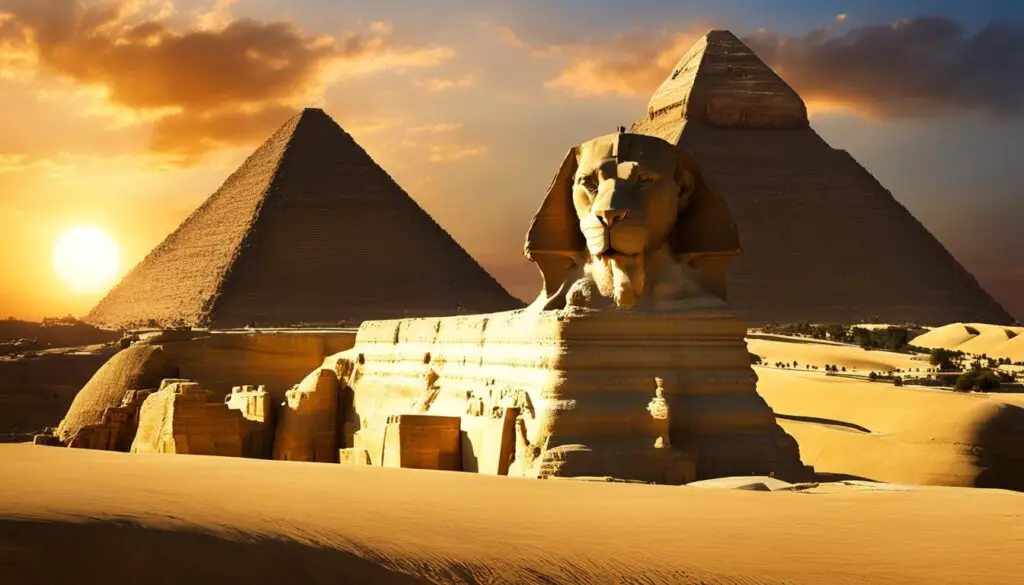
Exploring the Temples of Luxor
The Temple of Luxor, located in the ancient city of Thebes, is a fascinating site that offers a glimpse into the rich history of ancient Egypt. This magnificent temple was dedicated to the rejuvenation of kingship and was once the center of important religious festivals and rituals.
The grandeur of the Temple of Luxor is evident in its impressive architecture. The temple complex features massive columns, intricate carvings, and majestic statues. The entrance is guarded by a row of sphinxes that lead to the spectacular Great Court, where religious ceremonies and processions took place.
During ancient times, the Temple of Luxor played a significant role in religious festivals. One of the most important festivals held here was the Opet Festival, which celebrated the sacred union of Amun, Mut, and Khonsu. The festival included grand processions, music, dancing, and offerings to the gods.
“The Temple of Luxor is a testament to the devotion and architectural prowess of ancient Egypt. Its grandeur and intricate details provide a window into the religious and cultural practices of the time.” – Egyptologist Dr. Sarah Johnson
Table: Temples of Luxor – Key Features
| Temple | Location | Key Features |
|---|---|---|
| Temple of Luxor | Thebes, Egypt | Massive columns, intricate carvings, Great Court, The Avenue of Sphinxes |
Today, the Temple of Luxor is a popular tourist attraction and a UNESCO World Heritage site. Visitors can explore the various sections of the temple, marvel at the stunning architecture, and learn about the rituals and festivals that once took place here. The temple complex also offers breathtaking views of the Nile River, adding to its allure.
Exploring the Temples of Luxor allows visitors to step back in time and immerse themselves in the ancient wonders of Egypt. The temple’s historical significance and architectural beauty make it a must-visit destination for anyone interested in ancient Egyptian culture and rituals.
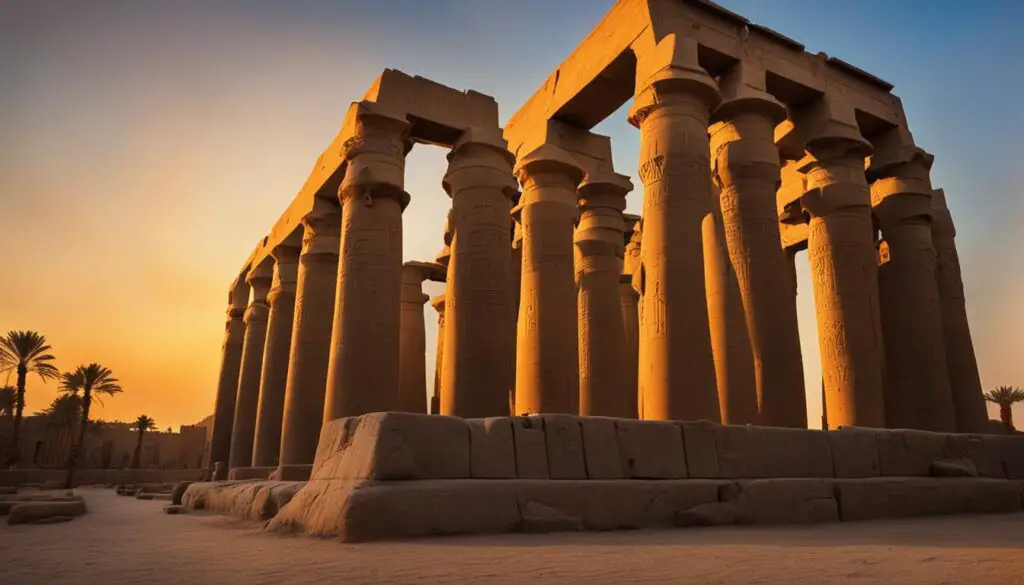
Ancient Treasures of Cairo
Cairo, the ancient capital of Egypt, is a city steeped in history and home to a multitude of historical landmarks that offer a glimpse into its rich past. One of the must-visit attractions in Cairo is the Egyptian Museum, which houses a vast collection of artifacts that date back thousands of years. From intricate jewelry to beautifully preserved mummies, the museum provides a fascinating insight into ancient Egyptian culture and civilization. The museum’s most famous exhibit is undoubtedly the treasures of Tutankhamun, including his iconic golden mask.
Another area of Cairo that captures the essence of its ancient history is Islamic Cairo. This historic district is home to numerous mosques, madrasas, and beautiful Islamic architecture. The stunning Al-Azhar Mosque, one of the oldest Islamic universities in the world, is a prominent landmark in the area. The Al-Muizz Street, lined with shops dating back centuries, is a bustling marketplace where visitors can immerse themselves in the vibrant atmosphere of Cairo.
“Cairo is a treasure trove of ancient wonders, offering visitors a chance to explore the fascinating history and culture of Egypt.”
The Egyptian Museum
The Egyptian Museum, officially known as the Museum of Egyptian Antiquities, is located in Tahrir Square and is a must-visit for history enthusiasts. The museum houses an extensive collection of ancient artifacts, including statues, sarcophagi, and exquisite jewelry. Walking through the halls of the museum is like stepping back in time, as you get a glimpse into the lives of the ancient Egyptians. One of the highlights of the museum is the Tutankhamun exhibit, which showcases the treasures found in the tomb of the young pharaoh, including his iconic golden mask.
Islamic Cairo
Islamic Cairo is a historic district that showcases the rich architectural and cultural heritage of the Islamic era in Egypt. The district is home to numerous mosques, madrasas, and Islamic monuments that date back centuries. One of the most prominent landmarks in Islamic Cairo is the Al-Azhar Mosque, known for its stunning architecture and historical significance as a center of Islamic learning. The bustling Al-Muizz Street, lined with shops and cafes, offers a vibrant atmosphere where visitors can experience the unique blend of ancient and modern Egypt.
Exploring the ancient treasures of Cairo is a journey back in time, offering a chance to uncover the mysteries and marvels of Egypt’s fascinating past. From the Egyptian Museum to the historic district of Islamic Cairo, this ancient capital continues to captivate visitors with its wealth of historical landmarks and cultural heritage.
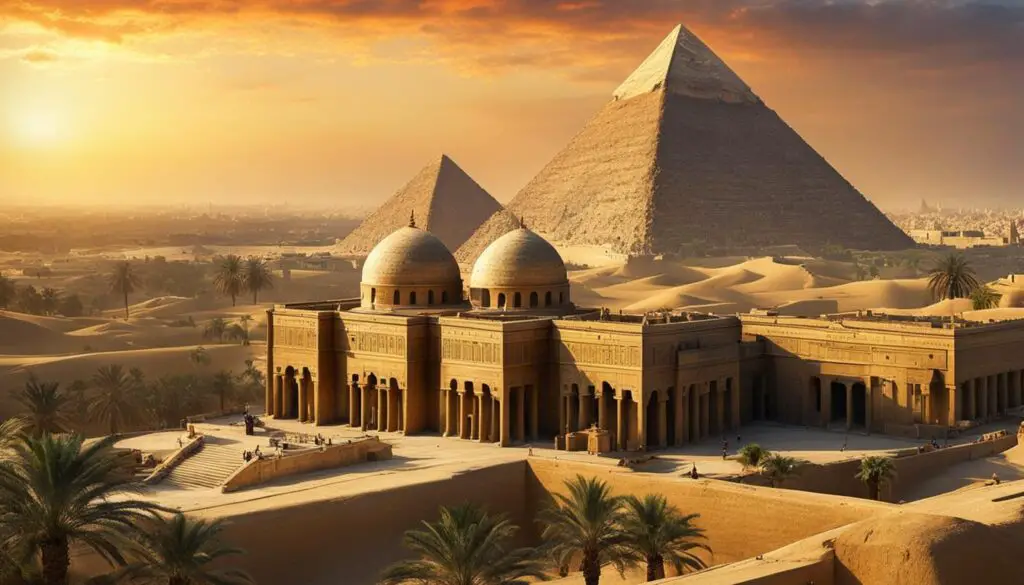
Abu Simbel and Saqqara: Hidden Gems of Egypt
When exploring the wonders of Egypt, it’s easy to become captivated by the iconic Pyramids of Giza and the majestic Nile River. However, there are other hidden gems that should not be overlooked. Two such gems are Abu Simbel and Saqqara, archaeological sites that offer unique insights into ancient Egyptian history and culture.
Abu Simbel
Nestled in the southern part of Egypt, Abu Simbel is home to two magnificent rock temples. These temples were commissioned by the renowned pharaoh Ramesses II and were carved out of the mountainside. The most striking feature of Abu Simbel is the colossal statues that guard the entrance of the temples. These statues depict Ramesses II himself, seated on his throne, projecting power and authority.
One of the most remarkable aspects of Abu Simbel is its biblical importance. The site is believed to be the possible location of the biblical city of Succoth, which is mentioned in the Book of Exodus. This adds another layer of historical and cultural significance to the already awe-inspiring site.
Saqqara
Located near Cairo, Saqqara is an ancient burial ground and a true testament to the grandeur of ancient Egyptian civilization. At the heart of Saqqara stands the Step Pyramid of Djoser, the world’s oldest standing step pyramid. This architectural marvel marked a significant shift in burial practices and symbolized the transition from mastaba tombs to grand pyramids.
In biblical times, Saqqara was closely linked to the story of Joseph, who was sold into slavery and later rose to become a powerful figure in ancient Egypt. The events surrounding Joseph’s journey and his eventual rise to power had a profound impact on the history of Saqqara and the entire region.
Today, both Abu Simbel and Saqqara continue to attract visitors from around the world who are eager to uncover the secrets of ancient Egypt. These hidden gems provide a deeper understanding of the country’s rich history and offer a unique perspective on the lives and beliefs of the ancient Egyptians.
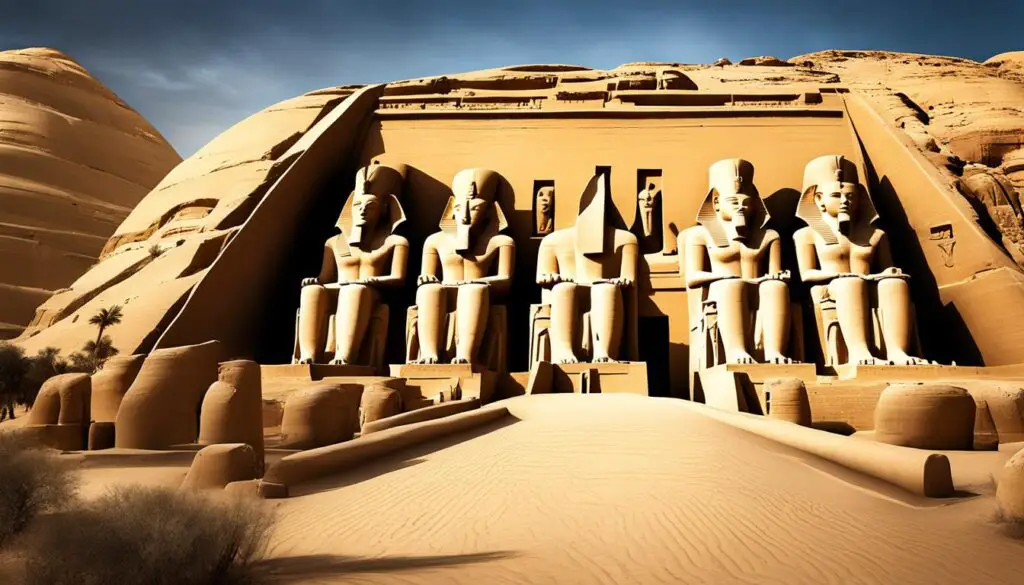
| Abu Simbel | Saqqara |
|---|---|
| Location: | Location: |
| Southern Egypt | Near Cairo |
| Significance: | Significance: |
| Biblical importance as a possible location of Succoth. | Biblical significance linked to the story of Joseph. |
| Main Features: | Main Features: |
| Colossal statues of Ramesses II. | The Step Pyramid of Djoser. |
Conclusion
Egypt, with its ancient wonders, holds a significant place in history, culture, and mysteries. This captivating country offers a range of experiences that allow travelers to delve into its rich past and immerse themselves in ancient civilization. From the iconic Pyramids of Giza, showcasing the amazing architectural prowess of the ancient Egyptians, to the enchanting temples of Luxor, Egypt offers a unique journey through time.
Exploring Egypt means unraveling the mysteries and marveling at the wonders that have captivated people for centuries. The biblical importance of this land cannot be understated, as it is the backdrop of major biblical events. Notable biblical figures, such as Moses and the Israelites, walked these lands, leaving an indelible mark on its history.
In biblical times, Egypt was a thriving civilization with remarkable achievements in architecture, art, and culture. The majestic Nile River served as a lifeblood, nurturing the fertile lands and enabling agricultural prosperity and abundant trade. It was a land of grandeur and opulence, as evidenced by the temples, tombs, and artifacts that have survived to this day.
Today, Egypt continues to intrigue and enthrall visitors from all over the world. Its ancient wonders stand as a testament to the ingenuity of the ancient Egyptians, while its vibrant culture and warm hospitality embrace visitors. Whether you are exploring the iconic Pyramids of Giza, cruising down the Nile River, or immersing yourself in the bustling streets of Cairo, Egypt offers a truly unforgettable travel experience.
FAQ
What is Egypt famous for?
Egypt is famous for its ancient civilization, iconic pyramids, and rich history.
What are the Seven Wonders of Egypt?
The Seven Wonders of Egypt include the Great Pyramid of Giza, the Great Sphinx, the Temple of Luxor, Cairo, Abu Simbel, Saqqara, and the Temple of Karnak.
What was ancient Egyptian civilization like?
Ancient Egyptian civilization was characterized by powerful pharaohs, intricate hieroglyphs, and a deep connection to the Nile River. Daily life revolved around agriculture, religion, and the arts.
What are the Pyramids of Giza?
The Pyramids of Giza are ancient tombs, including the Great Pyramid, built for the fourth dynasty Egyptian pharaoh Khufu. They showcase the impressive architecture and engineering skills of the ancient Egyptians.
How did the Nile River influence ancient Egypt?
The Nile River provided water for agriculture, transportation for trade, and sustenance for the people. It played a pivotal role in the development of ancient Egypt.
What is the Great Sphinx of Giza?
The Great Sphinx of Giza is a massive half-human, half-lion statue. Egyptologists believe it represents King Khafra, but its purpose and construction are still subjects of debate and speculation.
What is the Temple of Luxor?
The Temple of Luxor is located in the city once known as Thebes. It was a center for ancient Egyptian festivals and rituals, built by Amenhotep III and Ramesses II.
What can I see in Cairo?
Cairo is home to the Egyptian Museum, historical landmarks of Islamic Cairo, and other ancient wonders. It offers a glimpse into Egypt’s rich history.
What are Abu Simbel and Saqqara?
Abu Simbel features two massive rock temples dedicated to Pharaoh Ramesses II, while Saqqara is a vast ancient burial ground and home to the world’s oldest standing step pyramid.
Why should I visit Egypt?
Egypt’s ancient wonders, rich history, vibrant culture, and captivating mysteries make it a must-visit destination for travelers. It offers a unique opportunity to explore and uncover the secrets of ancient Egyptian civilization.







